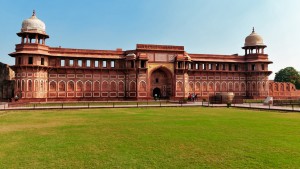Agra Fort the main residence of the emperors of the Mughal Dynasty

Agra Fort was the main residence of the emperors of the Mughal Dynasty. It is almost 2.5km from the Taj Mahal and is built in the 94 acres of land. The construction of this monument started in 1565 by Mughal Emperor Akbar and later on it came under hands of his grandson Shah Jahan.
Information to Know:
- Entry fee :
For Indians - INR 35
For Foreigners - INR 550
- Opens all days of the week from 6:00am to 6:00pm
- Mobile phones are to be kept switched off
History:
It was built with the purpose to keep enemy forces at bay. There was an exclusive gate meant for Akbar and his security, which is now controlled by Indian Army. In 1556, Akbar rebuilt the whole fort with red sandstone as by that time it had lost its sheen.
Architecture:
There are two halls, Diwan-e-Am and Diwan-e-khas. Diwan-e-Am was to address public by Shah Jahan and Diwan-e-khas was built to discuss foreign matters. Nagina Masjid was the chamber for the royal women. Shish Mahal made up of multiple mirrors is one of the most interesting structures over that place.
What to see in Agra Fort:
- Jahangiri Mahal
- Khas Mahal
- Musamman Burj
How to reach:
Idgah bus stand is the biggest bus terminal of Agra and Agra Fort is almost 4kms away from this stand. Agra Fort Railway Station situated in Mantola is the railway station nearby Agra Fort at a distance of 2kms. Agra airport is the nearest airport to this location.
Places to visit near Agra Fort:
Mehtab Bagh – It is a garden built along the Yamuna River and is situated at the north of the Taj Mahal complex. It is in square shape and is a classical style of Mughal Garden.
Mariam's Tomb - It is the mausoleum of Mariam-uz-Zamani. Built by Sikander Lodi, there are more than 40 chambers. Mariam’s cenotaph is right in the centre of the ground floor. The exterior of the structure is made of red sandstone with a rectangular structure that has an arch.
Ram Bagh - It was constructed by Babur. The garden is divided into quarters by stone-paved pathways. There are three levels in the garden that have been maintained. One level has flowers and vegetables, second has flower beds, with fine stone paved terraces and kiosk, and the third one has structures, terraces and tanks.
